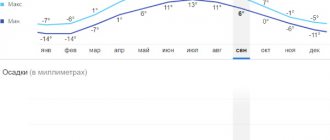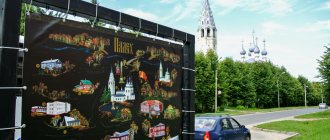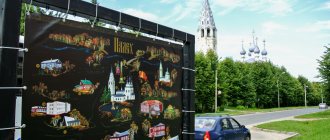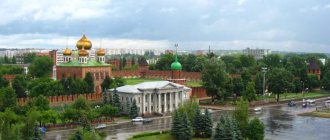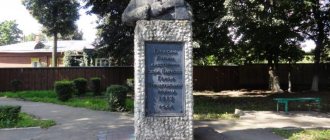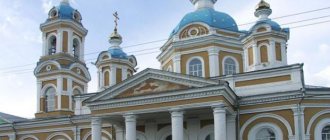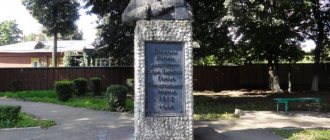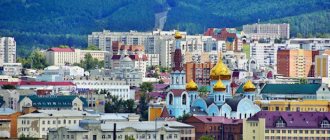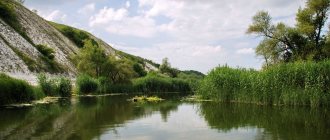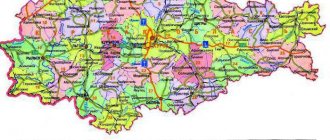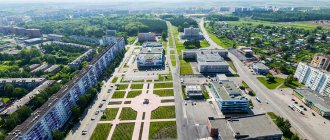The city of Semenov or “little Paris” is located in the very center of the Nizhny Novgorod region. A small but very beautiful town attracts with its rich, eventful history, original character, and abundance of attractions. Every year thousands of tourists come here to visit local museums, breathe fresh air, and get acquainted with the local culture.
The city has a rather interesting structure, for which it received its second name (“little Paris”). The settlement plan was approved by Catherine II. It had to be a huge square, which consists of 16 smaller squares. Two lines of streets were located diagonally, and at their intersection was the central square. Some of this structure has survived to this day.
Location of the area
The Semenovsky district is located in the left bank part of the Nizhny Novgorod region in the Kerzhenets River basin and borders on the east with Voskresensky and Krasnobakovsky, in the northeast with Varnavinsky, in the northwest with Koverninsky, in the south and southwest with the Borsky districts of the Nizhny Novgorod region. Its length from north to south reaches 95 kilometers, from west to east about 65 kilometers.
The district includes 18 administrative units, including 16 rural administrations, 1 village and 1 district. They unite 195 settlements, of which 186 are villages and hamlets, 2 stations, 7 settlements, including the urban-type settlement of Sukhobezvodnoye.
Tourist information
Semyonov is a seemingly quiet and unremarkable town. The infrastructure here is not developed, there are practically no entertainment centers for youth, teenagers and children - only cultural monuments and folk craft centers are of interest. Tourists rarely stay in the city for a long time - they usually visit it as part of complex excursions around the Nizhny Novgorod region, staying for one night.
There are not very many hotels in Semyonov. The three-star Paris Hotel is located closer to the center - it is very close to attractions, which is why tourists often stay here. A little further away are the hotels “Nimbus” and “Owl”, which have lower prices. The Semenovsky Ark hotel has recently opened with a picturesque garden and terrace. There is also a recreation center with its own beach, “Yagodnaya Derevnya,” which is worth paying attention to for those who want to spend more time in the city.
There are not very many cafes, bars and restaurants in Semyonov. In the center there is an establishment with traditional Russian fast food under the authentic name “Teremok”. The only restaurant in the city, Krezhenets, is located nearby. At the local factory there is an inexpensive cafe “Khokhloma”. For lovers of Japanese cuisine, there is a place with the simple name “Semyonov Sushi”, from where you can order delivery. For those who prefer to cook on their own, you can shop at Magnit or Pyaterochka, or go to a local farmers market with natural products.
There are no large shopping and entertainment centers in the city. A lover of shopping and souvenirs should stop by the shop at the factory, where you can buy the famous Semyonovsky wooden products.
Climate
The climate of the area is moderate continental with snowy, cold winters and humid, cool summers. The average air temperature in January is -?12.9 °C, in July - +18.4 °C.
On average, 550-600 millimeters of precipitation falls per year. In cool and cloudy summer conditions, when moisture loss through evaporation is small, excess moisture may occur. Such climatic conditions, along with infertile soils, are not conducive to the development of agriculture, but are generally suitable for human health and habitation.
Monastery New Sharpan
This monastery was founded by Old Believers in the 60s of the 19th century and was their refuge after the burning of the neighboring monastery by supporters of Nikonian reforms. In 1849, the icon of the Kazan Mother of God, proclaimed miraculous by the Old Believers, was removed from the monastery. As a result, the inhabitants of Sharpan moved to a neighboring monastery, which they called New Sharpan. Today it is for women, but even now you can come to it for worship.
Economy of the region
4.1. Industry
The region's industry is represented by 24 operating large and medium-sized enterprises. They produce 0.4% of the region's industrial output.
In terms of industrial production per 1 employed person, the district is almost 2 times behind the regional average (76,500 rubles in the Semyonovsky district and 155,800 rubles on average in the region).
The industrial specialization of the region is determined by mechanical engineering and metalworking. In the total volume of production, their share accounts for 45.8% of all industrial products produced here. Enterprises in these industries produce iron castings, fittings for the oil and gas industry, buses, woodworking machines, and safes.
The area has long been famous for its handicrafts, which are produced by two enterprises: painting and Semyonovskaya painting. They make furniture, toys, and souvenirs. Their share in industrial production is 19%.
In addition, the enterprises include such industries as chemical (production and processing of plastic), woodworking (production of lumber, plywood, skis, hockey sticks), light industry (production of flax fiber), flour milling and food industry (milk processing, bakery and confectionery products). products).
There are 5 budget-generating enterprises in the region: “Foundry and Mechanical Plant”, “Factory”, “Painting”. Their share in the industrial production of the region is 73%, in revenues to the local budget - 53% and in providing employment to the population - 66%.
In total, 5,342 people work in the industrial sector, which is 26% of the total number of people employed in the region’s economy.
List of the main industrial enterprises of the region:
- plant" - production of equipment. -mechanical plant" - production of equipment. "Semar" - car production (bankrupt, 2010). Establishment 62/14 - automobile production, Semenovsky district, Sukhobezvodnoe village. Establishment 62/1 - production of metal products, Semenovsky district, Sukhobezvodnoe village. — wood processing, Semenovsky district, village. I-Zaborskoe. painting" - wood processing. house Semenovskaya painting" - wood processing. Forestry" - wood processing. yard" - furniture production. Semenovsky forestry - forestry. milk" - food production. plant" - food production. MUP "Typography" - printing services. — non-metallic products (there is no longer an enterprise). comfortable houses" - production of wooden houses. -les" - wood processing. timber processing company - processing of plywood and wood. -Service - car repair. polyurethane foams" - chemical production. components for low-rise comfortable housing construction" - wood processing. -Lada-Service" - sale and repair of cars LLC "OGSMI" - production of PVC structures.
4.2. Agriculture
In the Semyonovsky district flax, potatoes, barley, oats, and wheat are grown. They raise cattle, cats, and sheep.
Currently, 21 agricultural enterprises and 69 peasant (farm) farms are engaged in agriculture in the region. In total, about 3,000 people are employed in agricultural production. This is almost 15% of the total number of people employed in the region’s economy.
Most agricultural enterprises specialize in livestock products. The share of gross production of milk and meat at comparable prices amounted to 60% of the total agricultural production of the region.
List of main agricultural enterprises in the region:
- -Zaborskoye: production of milk, meat; flax, potatoes SPK "Uspensky": production of milk, meat SPK "Ogibnovsky": production of milk, meat; potatoes SPK "Belasovsky": grain production SPK "Bokovaya": grain production SPK "Trud": milk, meat production SPK "Sukhobezvodnensky": milk, meat production: meat production: milk, meat production SPK "Raduga": meat production SPK " Nikitinsky": grain production: milk, meat production PT "Vector": milk, meat production PT "Poisk i K": grain production "Sand": grain production "Zubovo": feed production
4.3. Forestry
Forestry in the region is carried out by Semenovsky, Verkhne-Unzhensky, Koverninsky forestry enterprises and Semenovsky state rural forestry enterprise. In 1999, they carried out reforestation work on an area of 460 hectares (about 0.2% of the forest area), including planting forest crops on an area of 426 hectares. In order to improve the sanitary condition of forests and form better tree stands, thinning was carried out in young forests on an area of 612 hectares (more than 0.2%), forest thinning and sanitary felling on an area of 1484 hectares (0.5%). In addition, on an area of 730 hectares (0.3% of the forest area), work was carried out to transfer young forests to the category of valuable plantings.
4.4. Resources
4.4.1. Land resources
The territory of the region is located in a zone of excess moisture. There are extensive sphagnum and lowland bogs here. Swamp soils are distinguished by a large thickness of the peat layer. Their main characteristic feature is the gradual accumulation of semi-decomposed plant residues under conditions of excess moisture. In their natural state, these soils are unsuitable for growing agricultural plants.
The region is dominated by sandy loam and light loamy soils - 43.2% and 31.6% of the total area of the district, respectively; Medium loamy ones occupy 15% of the area, sandy ones - 6.7% and heavy loamy ones - 3.5%.
4.4.2. Mineral resources
The subsoil of the region contains certain types of non-metallic minerals. The only deposit of refractory clays in the Nizhny Novgorod region, Ryzhkovskoe, is located here. Its balance reserves amount to tons. In the area of the urban settlement of Sukhobezvodnoye, a promising occurrence of glass sands has been identified. Currently, geological exploration work is being carried out here. The area has large reserves of clays for building ceramics (more than 2 m?), construction sands -m?) and boulder-sand-gravel material -m?).
Rock salt layers were discovered at depths of about 500 meters (Belbazhskoye deposit, north of the regional center of Semenov along the Semenovsko-Koverninskoye highway). It is suitable for the production of chlorine and caustic soda, and can also be used in the food industry to produce premium quality table salt. In addition, in the area there are large deposits of peat, the layer thickness of which reaches 6-8 meters. (Kalgan and Keleynoye-Krivoye swamps). Peat deposits are developed only for agricultural needs and are not used in industry.
4.4.3. Forest resources
The total forest area of the Semenovsky district is a hectare (7.8% of the forest area of the region), of which a hectare is covered with forests. The forest cover of the region (the ratio of the area of forest land to the area of the district territory) is 73.7%, with the regional average being 50%. In terms of forest cover, it ranks 4th, second only to the Varnavinsky, Krasnobakovsky and Tonshaevsky districts.
According to their purpose, the forests of the region are divided into 2 groups:
protective strips along rivers and roads, forests of suburban green areas, which are of great importance in environmental protection; exploited forests.
According to the latest forest management data, the total timber reserves in the Semyonovsky district amount to ?., of which deciduous species - m?. The annual estimated cutting area for the Semyonovsky district is m?. wood, including:
- hardwood 330 thousand cubic meters. m? coniferous species 103 thousand cubic meters. m?
In 1999, 96.6 thousand cubic meters were prepared for industrial processing. m? wood, which is more than 2 times the level of 1998.
4.5. Transport
The city of Semenov is a major transport hub in the Nizhny Novgorod Trans-Volga region. The city of Semenov is connected with the regional center and neighboring areas by rail and road transport.
The Moscow-Kirov electrified railway passes through the Semenovsky district, connecting the center of the European part of the country with the eastern regions of Russia. There are 9 stations of this line in the area: Tarasikha, Osinki, station 506 km, Semenov, Zakharovo, Kerzhenets, Ozero, Kamenny Ovrag, Sukhobezvodnoye.
Two regional highways also pass through the area: P159
"Nizhny Novgorod - Kirov" and "Semyonov - Kovernino".
Yenovavtotrans is engaged in automobile passenger transportation in the region.” The company employs 162 people. The company's fleet consists of 42 transport units. The main brands of rolling stock are: PAZ-3205 - 26 units, PAZ-672 - 5 units, LAZ-695 - 7 units, LAZ-697 - 1 unit, LAZ-699 - 1 unit, KAVZ - 2 units. Passenger service is provided on 23 routes: 17 suburban, 4 urban, 2 intercity (Semyonov - Voskresenskoye, Semyonov - Kovernino).
The length of intraregional bus lines is 789.8 kilometers, of which:
- city lines - 19.6 kilometers. suburban - 624.5 kilometers intercity - 145.7 kilometers
Estate G.A. Vitushkina
Vitushkin was the owner of a spoon fishery. His house, built of red brick, was erected at the end of the 19th century. It is made in a style typical for the construction of small estates, characteristic of the end of the 19th century.
The building is unique due to its pronounced plasticity of the facade, as well as the massive arch of the gate. The building is richly decorated with numerous decorative elements. Currently, the Vitushkin estate houses the federal post office.
Location: Lenin street - 23.
Culture and education
The education system is represented by 72 institutions of various types, implementing general education programs, as well as programs of primary and secondary vocational education:
- secondary schools (35) lyceum technical school for mechanical wood processing agricultural technical school vocational school art lyceum
The preschool educational system includes 34 preschool educational institutions (DOU) (10 in urban areas, 24 in rural areas), in which 1,794 children are educated. Of all the preschool educational institutions, there are 5 kindergarten schools, 2 of which are located in rural areas. All preschool educational institutions are municipally owned and financed from the district budget. The coverage of children aged 1-7 years in preschool institutions in 1999 was 64%. There are 62 children per 100 places (45 in rural areas and 78 in urban areas).
Within the structure of the preschool educational system, 5 elementary kindergarten schools operate successfully. In the district, much attention is paid to the adaptive model of preschool education that meets the family’s needs for educational services. Along with educational preschool educational institutions (27 units), there are 5 kindergartens in the region with priority development of pupils, 3 preschool educational institutions are combined-type institutions, in which, in addition to general education, they provide compensatory services to eliminate speech deficiencies, posture, and care for children with severe physical disabilities. and mental disorders.
In Semyonov there is an orphanage where 32 children are raised, and a boarding school where mentally retarded children are educated. There is a lyceum in the area, where in-depth study of a number of subjects is carried out:
- in the math class - mathematics, physics, computer science in the humanities class - literature, history, foreign language in the science class - biology, chemistry, physics
Secondary school No. 1 provides specialized training in two areas: economics and law.
A children's music school has been opened in Semenovo, where 231 students study, 34 children study in its rural branches. They have the opportunity to undergo training in 4 departments: theoretical, piano, stringed instruments, folk instruments.
The region has developed artistic crafts, the preservation and continuation of the traditions of which is impossible without constant work with masters and without preparing worthy replacements. To this end, the city has developed a fairly consistent system of training and educating the younger generation in the spirit of respect for folk crafts and the traditions of the region. In kindergartens there are groups to develop the skills of drawing Khokhloma ornaments. School-age children have the opportunity to improve their skills in youth creativity clubs. The most gifted continue their studies at the Semenovsky Art Lyceum, where for 4 years experienced masters of Khokhloma painting teach them drawing, turning, and wood carving.
The lyceum is the only one in Russia that trains personnel for the production of Khokhloma. It traces its history back to 1916. In the year of opening, the then school had only 12 people specializing in wood painting and carving. Currently, there are more than 200 people studying there in four departments in the following specialties: wood turner, wood painting artist, cabinetmaker, artistic carving.
There are 2 technical schools on the territory of the district: Semenovsky Technical School of Mechanical Wood Processing and Ilyino-Zaborsky Agricultural Technical School. The Semenovsky Technical School of Mechanical Wood Processing annually recruits applicants for the following specialties:
- woodworking technology (qualification - technician) maintenance and repair of industrial equipment (technician) economics, accounting control (accountant)
Ilyino-Zaborsky Agricultural College trains specialists to work in commercial structures - lawyer, accountant, accountant-auditor
Vocational school No. 59 trains future builders, machine operators, and electricians
Interesting monuments in Semenov
Of course, Semyonov is not without monuments and memorials, where you can go to take memorable photographs.
Monument to Boris Kornilov
- Address: Boris Kornilov Square.
A native of Semenov became famous as a poet and lyricist, fell under the “machine of repression” and was shot at the age of 31, and was rehabilitated in the 50s. On the occasion of the 60th anniversary, which Boris Kornilov could have celebrated in 1967, his memory in his homeland was immortalized with a monument. The sculptural image of the poet was created by the Moscow author Anatoly Bichukov, People's Artist of the RSFSR.
War Memorial
- Address: Semyonov Station street.
Another work by sculptor A. Bichukov can be seen in Semenov on Chernyshevsky Street in Victory Park. A bronze figure of a soldier stands on a marble pedestal reminiscent of the Soviet flag. This is a military memorial dedicated to the memory of Semenovites who died on the fronts of the Great Patriotic War. It was installed in 1985.
Monument to Internationalist Warriors
- Address: Zavodskaya street.
There are monuments to victims of local military conflicts, often called “monuments to internationalist soldiers,” in many Russian cities. In Semenov it is a composition of two black granite steles and a bell. The monument was erected in 2012 on Chernyshevsky Street. Every year on February 15, city residents lay flowers here.
Bust of Vasily Kuznetsov
- Address: Lenin Square.
A diplomat and politician of the Soviet era, twice awarded the title of Hero of Socialist Labor, Vasily Vasilyevich Kuznetsov was born in the Nizhny Novgorod region. The monument to the statesman, erected in Semenov in 1982, is a bronze bust on a granite pedestal. This is the work of famous masters Leonid Kerbel and Sergei Khadzhibaronov.
Monument to Three Communists
- Address: Lenin street.
In 1979, when the city of Semenov celebrated its 200th anniversary, a sculptural composition consisting of three male figures was installed on October Revolution Square. Their prototypes were real people, ordinary workers who were ardent supporters of the Communist Party. History has preserved their surnames: I. Kozlov, A. Delfontsov and N. Zavyalov. In their person, the city paid tribute to all the “fighters for Soviet power” who died in revolutionary fervor.
Monument to V.I. Lenin
- Address: Lenin Square.
The symbol of the socialist era is the monument to V.I. Lenin, installed in the city center on the square of the same name in 1952. The author of the monument is the famous sculptor M.V. Tomsky. The figure of the leader is made of white stone and mounted on a pedestal of polished pink granite.
Medical institutions
On the territory of the Semenovsky district there are 7 hospital institutions with 510 beds, of which one hospital institution is located in the city and 6 in rural areas.
In the area there is a polyclinic of the central district hospital (CRH) for 500 visits per shift, 3 medical outpatient clinics and 28 paramedic and obstetric stations. The clinic uses hospital-substituting technologies - a day hospital with 4 beds is organized, in which 326 people were treated in 1999.
102 doctors of various specialties work in the healthcare sector of the district. The number of mid-level medical workers is 399 people. There are 16.4 doctors per 10 thousand population of the region (the regional average is 43.2 doctors) and 60.4 paramedical specialists (the regional average is 104.4 people).
Historical and Art Museum
The gallery was located in the house of the Old Believer Peter Sharygin in 1980. The exhibition includes more than 20 thousand objects of artistic and historical significance. Among them are the famous matryoshka doll, and objects decorated with the Khokhloma pattern, ancient house boards carved into wood, and wooden Russian spoons. A unique exhibit here is the work of the nuns of the Old Believer monasteries, namely their beadwork. In addition, here you can get acquainted with the history of the Old Believers in Semyonovsky district.
Location: Vaneeva street - 5.
Population and national composition
The population of the region as of January 1, 2000 was 53,700 people, the population density was 13.8 people per km?. This is 1.5% of the total population of the region. 48.2% of the district’s population lives in the city of Semenov.
Over the last century, the population of the city of Semenov has constantly increased. If in 1916 the population was 5,000 people, then in 1939 - 12,000 people, in 1969 - 23,800 people, in 1989 - 29,900 people.
The age structure of the population as of January 1, 2000 is characterized by the following data: the working population makes up 53% of the total population (in the region - 58%), persons over working age - 28% (24%), under working age - 19% (18%). ). Over the past 10 years, there has been a gradual “aging” of the population, which is expressed, firstly, in the excess of the share of pensioners over the share of people under working age in the total population and, secondly, in the increase in the ratio of these age groups in relation to each other. friend - if in 1990 the number of the old population exceeded the number of the young by 23%, then in 1999 - by 45%.
The demographic burden per 1,000 people of working age is 884 disabled citizens (727 in the region), including 523 people older and 361 people younger than working age.
In the Semenovsky district the female population predominates, which is 5,700 people more than the male population. In total, women make up 55% of the total population.
Museum-tourist
- Address: st. Chkalova, 18 V, tel. +7 (83162) 5-61-41, 5-63-33;
- Website: https://goldenhohloma.com;
- Opening hours: daily 10:00 to 18:00 (Sunday until 16:00), Saturdays from 10:00 to 13:00;
- Ticket price for adults is 60 rubles, for children – 30 rubles. The cost of participation in the master class is 130 rubles.
The factory produces a wide variety of Khokhloma products: sets of dishes, panels, famous carved ladles, painted furniture and much more. Guests will learn a lot of interesting things from the history of painting, try to master painting on their own, and watch a theatrical performance. The collection of unique Khokhloma products - giant cups, spoons and furniture - deserves special attention.
Religion
There are 6 Orthodox churches registered and operating in the district
- All Saints Church, Semyonov town, Trinity Church, Medvedevo village, Vladimirskaya Church, Svetloye village, Paraskeva Pyatnitsa Church, Pyatnitskoye village, Tikhvinskaya Church, Ilyino-Zaborskoye village, All Saints Church, Sukhobezvodnoye village
The Orthodox Church has the greatest influence on the population of the area, but at the same time, historically, the area is Old Believers. The Old Believers are represented mainly by three agreements: Bespopovsky, Beglopopovsky and Belokrinichsky.
In Semyonov there is an Old Believer “Nikolskaya Church” of the ancient Orthodox Christians of the Beglopopovites.
The influence of religious associations is gradually increasing: visits to churches are becoming more widespread, the number of weddings, baptisms, and funeral services in churches is increasing. [ source not specified 780 days
]
Churches of Semenov: which temples are worth visiting
Historically, in the religious culture of the city of Semenov, traditional post-reform Orthodoxy coexisted with the Old Believer cult, which was reflected in the sights of the city, becoming its interesting feature.
Old Believer Church of St. Nicholas of Christ
- Address: st. Volodarsky, 12A.
The Old Believer tradition includes the Church of St. Nicholas or St. Nicholas Church. The elegant building in the pseudo-Russian architectural style appeared only at the beginning of the 20th century; the completion date of construction is indicated as 1916.
A single-domed church with a hipped bell tower was erected on the site of a previously existing wooden church dating back to the beginning of the 18th century.
The construction was financed by the merchant Nosov. After opening, the temple did not operate for long. During Soviet times, namely in 1938, the temple was closed. The period of “idleness” lasted 51 years, in 1989 restoration began, the temple returned to religious life.
All Saints Church
- Address: Gagarin street.
The Church of All Saints in Semenov is a brick building belonging to the Russian-Byzantine architectural style. Erected on the site of an old cemetery in 1863. The single-domed temple, built according to the “quadrangle” principle common in temple architecture, has two aisles, connected to a bell tower and a refectory. Topped with an onion dome. After its closure and a period of religious oblivion during the Soviet era, the religious building was used as a water pumping station. Became active again in the 1990s.
Old Believer Monastery New Sharpan
- Coordinates on the map: 56.852496, 44.416107.
Since the 18th century, on the Kerzhenets River there was an Old Believer monastery of Sharpan, the main shrine of which was the icon of the Kazan Mother of God, considered by zealots of the old faith to be Miracle-working. According to legend, she ensured the prosperous existence of the monastery.
In 1849, the icon was taken away by the writer A.I. Melnikov-Pechersky, in the same year the monastery was plundered. After these events, representatives of the community went to the burial place of the nun Fevronia, founding a successor monastery there. The monastery was dubbed “New Sharpan”. The schema-nice led a hermit life, honoring the traditions of their faith.
There is evidence that by 1917 there was only one nun left in the monastery named Dorothea, but officially it existed until 1928. Nowadays, the New Sharpan monastery attracts many tourists interested in history and culture, and for adherents of the Old Believers, the preserved grave of Fevronia remains a place of worship.
Church of the Life-Giving Trinity in Medvedevo
- Address: Semenovsky urban district, Medvedevo village.
In the village of Medvedevo, Semenovsky district, there is a Trinity Church, built in 1925. The modest white stone building with a rounded dome is complemented by a massive and majestic red brick bell tower, which is a striking architectural dominant. The temple was closed during Soviet times. Nowadays, it is again active and belongs to the Nizhny Novgorod diocese of the Russian Orthodox Church.
Holy spring Osinkovsky
- GPS coordinates: 56.738734, 44.307376.
Not far from the village of Osinki, Semenovsky district, a holy spring flows, which is not only a natural, but also a cult and historical object. Once upon a time there was a large and prosperous Old Believer monastery in these places. At the beginning of the 17th century, in the era of Peter the Great, under the threat of ruin, its inhabitants committed a ritual of self-immolation.
On the site of the cells, a well-maintained cemetery has been organized, the graves are marked with crosses. The Osinkovsky well, as it is called in a number of historical documents, is a symbol and mute witness of the Old Believer history of the place. Today it is well maintained; a wooden chapel has been erected over the source.
Content
- 1 Geography
- 2 History
- 3 Population
- 4 Heraldry
- 5 Administrative device
- 6 Economics
- 7 Minerals
- 8 Trade and services
- 9 Communications and telecommunications
- 10 Media
- 11 Transport
- 12 Education
- 13 Culture
- 14 Sports
- 15 Sights, museums
- 16 See also
- 17 Notes
- 18 Literature
- 19 Links
Culture[ | ]
District House of Culture
There are several public associations in the city:
- Folklore ensemble "Rodniki" of the Semenovsky District House of Culture. Founded in August 1994. Participant in the TV show “Play Accordion” by Zavolokin in 1995. Laureate of the folklore competition named after. Livanov 1996 in Nizhny Novgorod. Participant in a TV show prepared by Chuyanov on NTV in 1996. Participants of the Russian Folklore Festival in Ipswich (England) in April-May 1997. Ensemble leader: Kuptsov Valery Pavlovich.
- Poetic association "Springs".
Transport[ | ]
Old Believer Church in the name of St. Nicholas the Wonderworker City of Semyonov.
October Revolution Square. A monument to three communists who died in 1919 in a battle with counter-revolutionary bandits hiding in the forests near the village of Olenyevo. (1979) Outside the city there is a highway of regional significance Nizhny Novgorod-Kirov. There is a railway station on the new direction of the Trans-Siberian line. Electric trains run to Nizhny Novgorod approximately every hour. Travel time is about 1 hour. The fare is 160 rubles. There is one train stop within the city - platform 506 km, connecting the station and the central part of the city with the Zavodskaya Street microdistrict.
Transport within the city is carried out by JSC Semenovsky Autopark and a small number of private carriers. The bus station is located in the railway station building. There are city, suburban and intercity routes.
The traffic situation on the streets is usually free; there may be minor traffic jams only during rush hours in the central part of the city.
Education[ | ]
In Semenov there are four secondary schools, an Orthodox gymnasium named after. St. Apostle and Evangelist Luke, evening school, Lyceum named after. A. S. Pushkin.
State educational institutions of vocational education:
- GBPOU "Semyonovsky Industrial and Art College" (GBOU SPO SIHT).
Branches of higher educational institutions:
- Semenovsky branch of Nizhny Novgorod State University named after. N. I. Lobachevsky
Population[ | ]
| Population | ||||||||
| 1856[8] | 1897[8] | 1913[8] | 1926[8] | 1931[8] | 1959[9] | 1967[8] | 1970[10] | 1979[11] |
| 2800 | ↗3800 | ↗5100 | ↗6000 | ↗7500 | ↗19 837 | ↗23 000 | ↗23 633 | ↗25 199 |
| 1989[12] | 1992[8] | 2000[8] | 2001[8] | 2002[13] | 2003[8] | 2005[8] | 2006[8] | 2008[14] |
| ↗26 282 | ↗26 600 | →26 600 | ↘26 500 | ↘25 298 | ↗25 300 | ↘25 000 | ↘24 800 | ↘24 433 |
| 2009[14] | 2010[13] | 2011[8] | 2012[15] | 2013[16] | 2014[17] | 2015[18] | 2016[19] | 2017[20] |
| ↘24 351 | ↗24 473 | ↗24 500 | ↘24 433 | ↗24 442 | ↗24 503 | ↘24 451 | ↗24 583 | ↘24 536 |
| 2018[21] | 2019[22] | 2020[1] | ||||||
| ↘24 400 | ↘24 180 | ↘24 067 | ||||||
Sports[ | ]
| This section is excessively long or contains unimportant details. If you do not agree with this, please show in the text the materiality of the material presented. Otherwise, the section may be deleted. Details may be on the talk page. |
- Sports and recreation center "Arena" (opened on June 6, 2008, there is a football field with artificial turf, classes are held in sections in many sports).
- In 2009, FC Semenov won the Regional Football Cup.
- In 2015, Semenovsky FC “Semar-Service” won the Nizhny Novgorod Region Regional Champions Cup in mini-football.
- In the city of Semyonov, the Thai boxing and kickboxing club “Mankong” is engaged.
Heraldry[ | ]
Historical coat of arms of Semenov (1781)
The first coat of arms of the city of Semenov was approved on August 16, 1781[23].
The coat of arms of the Semenovsky urban district was approved on February 16, 2012.
The coat of arms is a heraldic shield bordered by a red stripe, consisting of two parts: in the upper part - “a scarlet (red) deer walking in a silver field, having horns with six branches and black hooves,” indicating belonging to the Nizhny Novgorod region, on whose territory the city of Semenov is located; in the lower part there is a fire made of logs stacked in a pyramid on a golden field, signifying the great importance of forests and woodworking in the life of the population. The dividing strip between the fields is red with an element of Khokhloma painting in gold, confirming the historical, cultural and economic significance of the folk craft[24].
